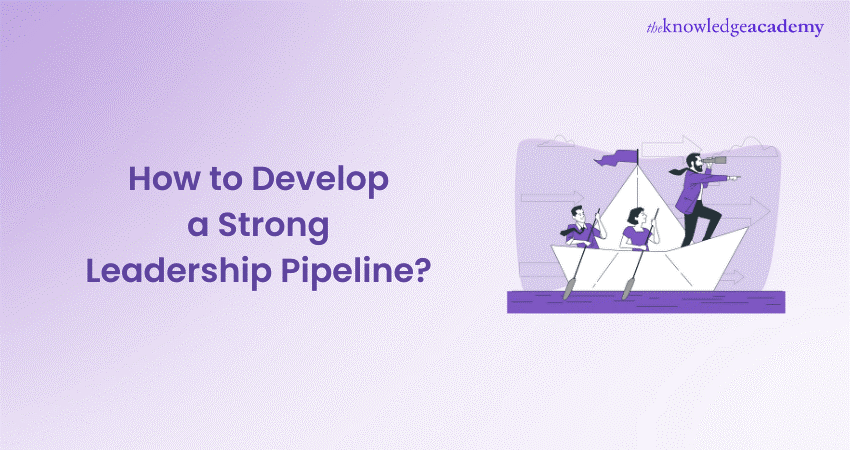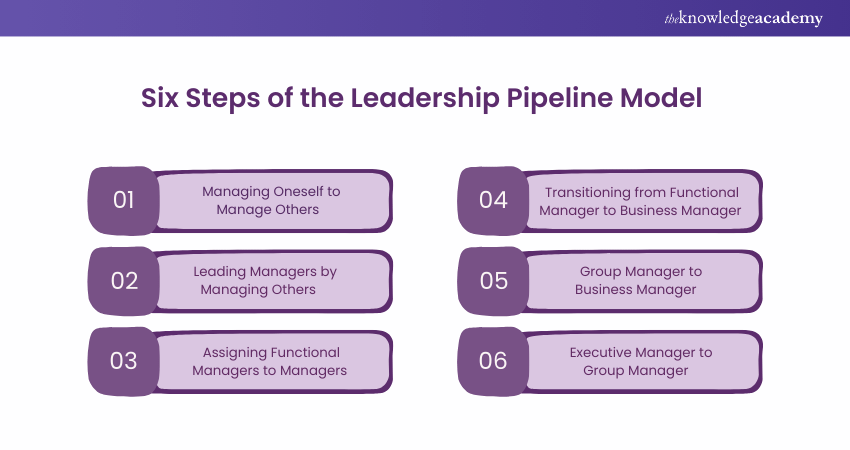We may not have the course you’re looking for. If you enquire or give us a call on 01344203999 and speak to our training experts, we may still be able to help with your training requirements.
We ensure quality, budget-alignment, and timely delivery by our expert instructors.

Leadership is one of the most critical factors for the success of any organisation. However, many organisations struggle to find and retain qualified Leaders who can drive performance, innovation, and growth. This is where a Leadership Pipeline comes in. A Leadership Pipeline systematically identifies, develops, and promotes Leaders from within your organisation. It ensures a steady supply of talented and capable Leaders ready to take on new challenges and opportunities.
Table of Contents
1) What is a Leadership Pipeline?
2) Reasons for Building Your Leadership Pipeline
3) The Six Steps of Leadership Pipeline Model
a) Managing Oneself to Managing Others
b) Leading Managers to Managing Others
c) Assigning Functional Managers to Managers
d) Transitioning from Functional Manager to Business Manager
e) Group Manager to Business Manager
f) Executive Manager to Group Manager
4) Conclusion
What is a Leadership Pipeline?
A Leadership Pipeline is a system in a company that constructs and sustains a succession Leadership Development Plan for leadership roles. The Leadership Pipeline model focuses on grooming individuals to become leaders through development, evaluation, training, and promotion, aiming to ensure a smooth succession process for the organisation's efficiency.
There are four essential elements of leadership pipeline which includes:
a) Individual Contributors
b) Managers
c) Mid-level Management
d) Executive Leaders
Reasons for Building Your Leadership Pipeline
When developing a leadership pipeline, it’s crucial to understand the purpose behind it. Organisations undergoing change or experiencing staff turnover need new leaders to quickly become proficient and acquire a demanding set of skills, which can be a significant challenge.
Reasons of Developing a Leadership Pipeline:
a) Clarity in Leadership Development: A pipeline clarifies how leaders are developed within an organisation, including selection criteria and the experiences that shape their growth. This transparency boosts employee engagement and motivation by providing a clear path for personal development and career progression.
b) Succession Planning: A Leadership Pipeline supports development at all levels, ensuring personnel are ready to step into roles as needed. It equips everyone, from entry-level to seasoned professionals, with the tools to advance in their careers.
c) Coaching from Existing Leaders: Developing a pipeline allows current leaders to mentor and coach future leaders, facilitating the exchange of ideas, processes, and visions for the future. This invaluable experience helps shape effective leadership.
d) Business Expansion: A well-developed Leadership Pipeline supports long-term business growth and expansion by preparing leaders for future opportunities and challenges, ensuring the organisation’s sustained success.
e) Improved Financial Performance: Selecting the right leaders for key positions impacts the business’s bottom line. Experienced leaders who understand growth opportunities can better position the organisation financially.
f) Effective Leadership Style Development: Building new leaders provides an opportunity to cultivate a leadership style that works, phasing out ineffective practices and fostering a new approach that aligns with the organisation’s goals.
Transform your Leadership approach and drive success in Agile environments with our Agile Leadership Training. Join today!
The Six Steps of the Leadership Pipeline Model
The Leadership Pipeline Model is one of the foremost and extensively applied frameworks for establishing a Leadership Pipeline. This model was crafted by Ram Charan, Stephen Drotter, and James Noel and was introduced in their book titled "The Leadership Pipeline: How to Build the Leadership Powered Company." The model describes six levels of Leadership, each with its skills, time applications, and work values.
It also explains the transitions that Leaders need to make as they move from one level to another and the challenges and pitfalls they may face. Here is a brief overview of the six steps of the Leadership Pipeline Model:

Step 1: Managing Oneself to Manage Others
The first step is transitioning from an individual contributor to a first-time manager. It is one of the most challenging and critical transitions in the Leadership Pipeline, as it requires a fundamental shift in mindset and behaviour.
Identify your organisation’s needs and start by auditing your current business structure. Identify business-critical roles that impact the company’s long-term health, including senior leadership positions, specialist roles, and functional managers. Look beyond essential roles for daily operations and consider those driving engagement, motivating teams, and championing your culture.
Step 2: Leading Managers by Managing Others
The second step is transitioning from a first-time Manager to a Manager of Managers. It is another challenging and important transition in the Leadership Pipeline, and a key moment for Leadership Team Development, requiring a further shift in focus and perspective.
Identifying potential leaders doesn’t mean throwing them in at the deep end. Training and development are crucial. Tailor your leadership training program to your business but ensure consistency.
Enhance your Leadership skills and become a more effective Leader with our specialised Leadership Skills Course. Register now!
Step 3: Assigning Functional Managers to Managers
The third step is transitioning from a Manager of Managers to a functional Manager. It is a significant and complex transition in the Leadership Pipeline, requiring a deep understanding and mastery of a specific function or domain.
Development should be continuous, not just when someone is up for promotion. Encourage growth at all levels, recognising that readiness for leadership varies. A flexible, inclusive program ensures talented individuals are included and prevents high performers from being pigeonholed into leadership roles prematurely.
Development opportunities outside formal programs can include job rotations, special assignments, action learning, and learning through exposure.
Step 4: Transitioning from Functional Manager to Business Manager
The fourth step is transitioning from a Functional Manager to a Business Manager. It is a major and demanding transition in the Leadership Pipeline, requiring a broad and holistic view of the business and the market.
Leverage the knowledge and experience of your current leaders. Their involvement in mentoring emerging leaders ensures business continuity and strategic alignment. Engage the entire leadership team in the process to foster a culture of knowledge sharing and trust.
Step 5: Group Manager to Business Manager
The fifth step is transitioning from a Business Manager to a Group Manager. It is a rare and challenging transition in the Leadership Pipeline, as it requires high Leadership maturity and agility.
Track the success of your Leadership Pipeline using metrics such as employee retention, promotions, lateral movements, engagement, feedback, and learning outcomes. These metrics help you continuously improve the program.
Step 6: Executive Manager to Group Manager
The sixth and final step is transitioning from a Group Manager to an Executive Manager. It is the most difficult transition in the Leadership Pipeline, requiring supreme Leadership wisdom and influence.
Keep your leadership development process simple, transparent, and open. This ensures fairness and equal opportunity, creating an environment where employees feel valued, empowered, and motivated to do their best.
Unlock your Leadership potential and elevate your career with our comprehensive Leadership Courses.
Conclusion
A Leadership Pipeline is vital for building and sustaining a high-performance organisation. It helps you to identify, develop, and promote your current and future Leaders at every level of your organisation. It also helps you create a clear and consistent career path for your Leaders and promote a culture of Leadership and accountability in your organisation. By following the six steps of the Leadership Pipeline Model, you can build a strong and effective Leadership Pipeline for your organisation.
Frequently Asked Questions
What are The Five Levels of Leadership Outline?

These five levels of leadership help leaders understand where they stand in their leadership journey. Hence, learning about these and executing them effectively can enable them to become experts in their roles.
a) Position
b) Permission
c) Production
d) People Development
e) Pinnacle
What are The Four Rules of Leadership?

The main four rules of Leadership to follow are:
a) Be Empathetic
b) Be Decisive
c) Recognise and Exploit Opportunities
d) Build Effective Teams
What are the Other Resources and Offers Provided by The Knowledge Academy?

The Knowledge Academy takes global learning to new heights, offering over 3,000 online courses across 490+ locations in 190+ countries. This expansive reach ensures accessibility and convenience for learners worldwide.
Alongside our diverse Online Course Catalogue, encompassing 19 major categories, we go the extra mile by providing a plethora of free educational Online Resources like News updates, Blogs, videos, webinars, and interview questions. Tailoring learning experiences further, professionals can maximise value with customisable Course Bundles of TKA.
What is The Knowledge Pass, and How Does it Work?

The Knowledge Academy’s Knowledge Pass, a prepaid voucher, adds another layer of flexibility, allowing course bookings over a 12-month period. Join us on a journey where education knows no bounds.
What are Related Courses and Blogs Provided by The Knowledge Academy?

The Knowledge Academy offers various Leadership Courses, including Leadership Skills and Agile Leadership Trainings. These courses cater to different skill levels, providing comprehensive insights into Organisational Leadership.
Our Business Skills blogs cover a range of topics related to Leadership skills and upskilling, offering valuable resources, best practices, and industry insights. Whether you are a beginner or looking to advance your Leadership skills, The Knowledge Academy's diverse courses and informative blogs have you covered.
Upcoming Business Skills Resources Batches & Dates
Date
 Leadership Skills Training
Leadership Skills Training
Fri 11th Apr 2025
Fri 27th Jun 2025
Fri 22nd Aug 2025
Fri 24th Oct 2025
Fri 12th Dec 2025






 Top Rated Course
Top Rated Course



 If you wish to make any changes to your course, please
If you wish to make any changes to your course, please


